HISTORIOGRAPHY: Orpen v. MacNeill: writing Anglo-Norman Ireland in the revolutionary decade
Published in Features, Issue 3 (May/June 2019), Volume 27Two competing visions of Ireland are played out in their works, but each, in his own way, transformed the study of medieval Ireland.
By Ruairí Cullen
The dawn of ‘scientific’ history writing in the nineteenth century produced little original work on the Anglo-Normans in Ireland. Historians had not been kind to Strongbow and his companions, who were branded as adventurers and freebooters, with tentative interest only developing with their ‘Hibernicisation’.
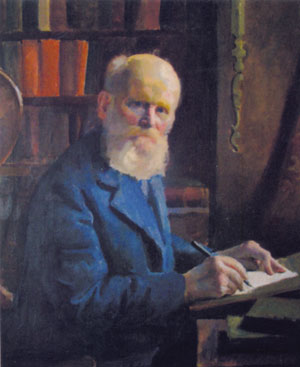
Above: Portrait of Goddard Henry Orpen by Seán O’Sullivan. Orpen’s four-volume Ireland under the Normans claimed to show for the first time that Anglo-Norman rule had been largely beneficial. (Orpen family)
Benefits of Anglo-Norman rule
As it became more apparent, however, that Ireland would receive some form of Home Rule, and the Gaelic League and other movements called for a ‘reversal’ of the English conquest through a celebration of distinctly Irish forms of culture, a two-volume text was published in 1911 that claimed to show for the first time that Anglo-Norman rule had been largely beneficial.
Ireland under the Normans by Goddard Henry Orpen (1852–1932) argued that the domination of the English Crown from the thirteenth century to the early fourteenth was ‘much more complete than has been generally recognized’ and that ‘due credit has not been given to the new rulers for creating the comparative peace and order and manifest progress and prosperity that Ireland enjoyed, during that period, wherever their rule is effective’. After the disruption of the invasion of Edward Bruce (1315–18), Anglo-Norman ‘progress’ was restricted to Dublin and chaos reigned outside ‘the Pale’.
The first two volumes of Ireland under the Normans were joined by another pair in 1920. Their publication soon sparked a negative review from leading historian and expert in Irish-language sources Eoin MacNeill (1867–1945), who took umbrage at the unflattering depiction of Irish ‘tribalism’ and political anarchy and pointed to the uncovering of new sources in older forms of Irish in contradiction of this. He returned to disparage Orpen’s interpretation on several occasions. In their differing takes on the consequences of the 1169 invasion we witness some of the political and cultural battles of contemporary Ireland being fought out in their rival works.
Orpen’s background
Born in 1852 and raised in Dublin, Orpen was the son of a Church of Ireland barrister of plantation stock. He followed his father into the law after studying classics at Trinity College Dublin. He married his cousin Adela Richards in 1880 and they moved to the London suburb of Chiswick. Never fond of the legal profession, Orpen indulged in antiquarian interests in his free time. Family summers were spent in Ireland, where Orpen visited many sites of interest on his bicycle to feed his enduring passion for the topography of the island and to investigate the origins of the mounds and ruins that pepper the Leinster landscape. Adela’s father gave the couple the deeds to his country house, Monksgrange, Co. Wexford, in 1900. From then on Orpen became a full-time independent scholar. Convinced Liberals until the party’s turn to Home Rule, the family gravitated to Conservative and Unionist politics, though it was Adela who became a dedicated activist while Goddard wrote history.
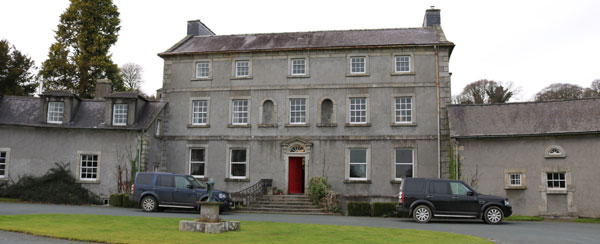
Above: Monksgrange House, Co. Wexford—Orpen’s home from 1900, inherited from his wife’s family, but he himself was not a traditional ‘big house unionist’ historian.
The first two volumes of Ireland under the Normans earned Orpen an international reputation. Despite some of the accusations from nationalist critics, Orpen’s argument was not simply anti-Irish or pro-English, as he condemned the conquerors for failing to develop sympathy with or understanding of the native Irish. There were lessons here for Irish unionist contemporaries, while at the same time Orpen implicitly urged nationalists to consider that it was through the English connection that heretofore unexperienced levels of peace and prosperity had reached Irish shores. Shocked and traumatised by the revolutionary decade, Orpen remained in Monksgrange and continued to publish intermittently until he died in 1932.
MacNeill’s background
MacNeill’s story is better known. Born to a Catholic family in the Glens of Antrim in 1867 and educated in Belfast, he moved south to take up a civil service post in Dublin. In the late 1880s he began to dedicate much of his time to learning Irish and studying older forms of the language. He threw himself into both the scholarly and popular revivalist movements, co-founding the Gaelic League in 1893. His scholarly reputation was such that he was asked to review Ireland under the Normans for a leading Irish historical journal.
He was appointed professor of early Irish history at UCD in 1909, but political developments proceeded to get in the way of his academic career. He called for the foundation of a nationalist volunteer force in 1913 to ensure the anticipated implementation of all-Ireland Home Rule, though he shared a troubled relationship with the Irish Republican Brotherhood and famously countermanded the call to arms at Easter 1916. Resolutely pro-Treaty but a reluctant politician, MacNeill was appointed minister for education in 1922, holding the post for three years before resigning and recommitting himself to his professorship.
Despite political differences, MacNeill and Orpen had much in common. Both were largely self-taught historians who gave up their initial careers for academic study. Both began their scholarly adventures with source criticism of neglected and misunderstood medieval manuscripts. Both were anxious to establish more verifiable time-lines for medieval Irish history, to work out who was who in the genealogies and the locations of places named in the sources. Each, in his own way, transformed the study of medieval Ireland.
Local versus national
A key difference, which illuminates the political context of their work, lies in the regional versus national framework of investigation. MacNeill’s essays were predominantly ‘national’ in perspective, with titles such as ‘Ireland’s golden age’ and ‘The Irish rally’. In contrast, Orpen argued that writing a history of national proportions about early medieval Ireland was a near-impossible task, as throughout ‘the whole historic period down to the coming of the Normans, the turmoil of inter-tribal conflicts has been the despair of writers who seek to tell a connected story’. His chapters reflected his view of Anglo-Norman Ireland as a ‘patchwork of lordships’, with its highly detailed studies of Anglo-Norman activity in specific areas.
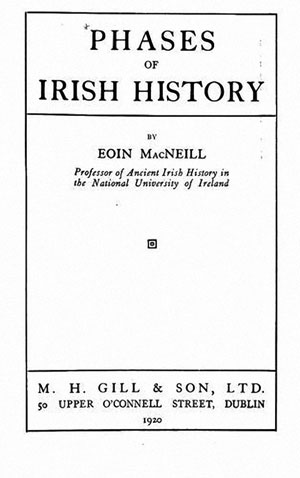
Above: Title-page of MacNeill’s Phases of Irish history, which exhibits little interest in the invaders.
As Orpen worked on Ireland under the Normans, other Irish historians of a unionist persuasion were also claiming that Irish history was for the most part a story of localised politics with little to unite its various strands. These historians were focused around Trinity College and included the early modernist Caesar Litton Falkiner and legal historian F.E. Ball. They built on the work of late nineteenth-century unionist politicians-turned-historians W.E.H. Lecky and Richard Bagwell, who had argued that it was an English victory over the Irish chieftains by the seventeenth century that had brought a sense of unity to Irish history. Orpen’s papers contain little correspondence with these figures, but the similarities in the perspectives of their works are striking. They all used similar arguments of Irish disunity to counter contemporary nationalists. This school of history failed to take off and nationally minded approaches were more prevalent from the 1920s.
MacNeill led a personal crusade against what he referred to as the ‘Ireland under’ historians—historians like Orpen and those above who were primarily concerned with narrating the Anglo-Norman, Tudor and Cromwellian conquests. He was dismissive of the claims of unionist historians to impartiality and balance, arguing instead that theirs was a cultural and political project to denigrate Irish history and culture. His politics greatly informed his work and he made no excuses for the nationalist slant to it.
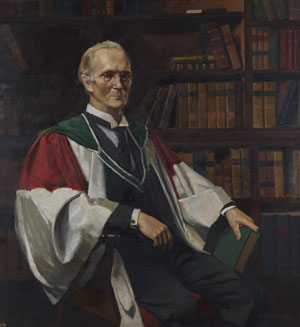
Above: Portrait of Eoin MacNeill by Seán O’Sullivan. Despite political differences, MacNeill and Orpen had much in common. (UCD Art Collection)
Nevertheless, despite the clear political messaging in MacNeill’s work, it is difficult to disagree with one of his successors at UCD that to him ‘belongs the credit of having dragged Celtic Ireland practically single-handed from the antiquarian mists into the light of history’. He dedicated his academic life to showing that the Irish-language sources like the genealogies, previously derided as fanciful, did contain information of historical interest that could be extracted by a careful and sympathetic scholar.
In contrast to Orpen, MacNeill was largely detached from mainstream British historical research, taking his guidance from the methods of comparative Celtic philologists. The chapters in MacNeill’s Phases of Irish history (1919) on the Anglo-Norman period exhibit little interest in the invaders themselves; rather he critiqued Orpen’s assertions that there was no sense of Irish unity and that the invaders brought previously unexperienced peace and law. MacNeill accused Orpen of being trapped by modern ideals of political governance, calling him a ‘whole-hearted worshipper of centralisation’ and ignorant of native source material. The powerful broadside that MacNeill delivered against this colonialist interpretation reduced the Wexford historian to a unionist bigot with no interest in native Ireland.
New archival evidence on Orpen
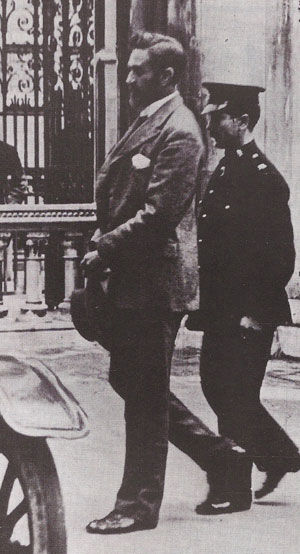
Above: Roger Casement—‘Wolfe Tone reborn. And also, thank God, about to die’, according to Orpen on hearing of his capture in 1916. (Daily Mirror Picture Library)
New archival evidence has recently been revealed in Orpen’s home of Monksgrange, Co. Wexford. The collection covers the 250 years of the house’s existence and has been catalogued and investigated by the historian Philip Bull after its discovery by resident Jeremy Hill, a descendant of Orpen. The more accurate picture that we now possess of Orpen reveals that he was not a traditional ‘big house unionist’ historian, with his background in the Dublin middle class and his interest in the Arts and Crafts movement.
Also present in the collection is Orpen’s diary, a segment of which covers Easter Week 1916. It is a characteristically objective account of what was a traumatic week for his family, particularly as his son Edward was abroad serving with the Royal Service Corps. This effort to be objective marks all of Orpen’s work and much of his correspondence. Nevertheless, he could not resist expressing his anti-nationalist views on occasion. For instance, in his account of the Easter Rising, he welcomed Roger Casement’s capture off the coast of County Kerry as Wolfe Tone redivivus. Et etiam, Dei gratia, moriturus (‘Wolfe Tone reborn. And also, thank God, about to die’).
In academic terms, the collection depicts a man with a deep and varied interest and proficiency in historical studies, unfairly maligned by MacNeill. It indicates that Orpen learnt Irish in London in the 1880s, sparking an interest that led to membership of the Irish Texts Society. He even attended Gaelic League meetings in the late 1890s.
By the early 1900s, however, Orpen had grown disenchanted with cultural revivalists’ uncritical elevation of ‘native’ forms of Irish culture. He wrote in Ireland under the Normans that ‘historical criticism and archaeological research have reduced to comparatively humble proportions the exaggerated notions of native writers as to the antiquity and the degree of civilization in early Ireland’. Revivalism had downplayed the role of foreign settlers, which was, according to Orpen’s own research, often positive. His prejudice lay not in a belief that the Irish language was without value but in his view that English rule represented progress in the face of Irish attachment to the forces of regression. Unfortunately, there appears to be no evidence of any correspondence between MacNeill and Orpen. We can only conjecture as to any meeting at the Irish Texts Society or the Royal Society of Antiquaries of Ireland; MacNeill succeeded the deceased Orpen to the presidency of the latter in 1932.
Ultimately, a major difference between our two historians is the emphasis they placed on the historical value of different sources. For MacNeill, the neglected Irish-language sources revealed a civilisation that had been masked and disparaged in many of the foundational sources of Ireland under the Normans—the records of the Anglo-Normans and the English state. Orpen borrowed freely from the methods of medieval historians in England, while MacNeill rejected what he saw as a historical approach that could never fully understand the sources of the native Irish.
Two competing visions of Ireland during the revolutionary decade are thus played out in their works. Orpen looked to England for both academic and political guidance. Despite making his own present-day parallels, it appeared to him that nationalist historians could not separate themselves sufficiently from their politics. In this inability to detach themselves from projecting their aspirations for modern Ireland onto the medieval period, perhaps he also interpreted an inability of nationalists to govern Ireland independently. MacNeill, on the other hand, embraced his own partisanship and saw his historical research as part of a wider political project to rescue the virtues of a medieval Irish civilisation—one that was independent of and just as valid as that across the Irish Sea. The methods and new approaches of Orpen and MacNeill may have changed the study of the Anglo-Norman invasion and medieval Ireland; they did not, however, take the politics out of history writing.
Ruairí Cullen received a Ph.D in history from Queen’s University, Belfast, in 2017.
FURTHER READING
F. Bull, Monksgrange: portrait of an Irish house and family, 1769–1969 (Dublin, 2019).
E. MacNeill, Phases of Irish history (Dublin, 1919).
G.H. Orpen, Ireland under the Normans, 1169–1333 (4 vols) (Oxford, 1911–20).
















